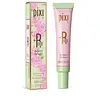What's inside
What's inside
 Key Ingredients
Key Ingredients

 Benefits
Benefits

 Concerns
Concerns

 Ingredients Side-by-side
Ingredients Side-by-side

Water
Skin ConditioningPropanediol
SolventEthylhexyl Palmitate
EmollientMica
Cosmetic ColorantDiphenylsiloxy Phenyl Trimethicone
Skin ConditioningDiisostearyl Malate
EmollientSteareth-21
CleansingSynthetic Fluorphlogopite
Glyceryl Stearate Se
EmulsifyingEthylhexyl Salicylate
UV AbsorberSqualane
EmollientPanthenol
Skin ConditioningRosa Damascena Flower Water
MaskingAscorbyl Palmitate
AntioxidantTocopheryl Acetate
AntioxidantRosa Rubiginosa Seed Oil
EmollientSodium Hyaluronate
HumectantCeramide NP
Skin ConditioningPelargonium Graveolens Oil
MaskingHydroxyethyl Acrylate/Sodium Acryloyldimethyl Taurate Copolymer
Emulsion StabilisingPolysorbate 20
EmulsifyingSorbitan Isostearate
EmulsifyingCetyl Dimethicone
EmollientHydroxyacetophenone
AntioxidantSteareth-2
EmulsifyingAcrylates/C10-30 Alkyl Acrylate Crosspolymer
Emulsion StabilisingSodium Hydroxide
BufferingPhenoxyethanol
PreservativeCitronellol
PerfumingGeraniol
PerfumingTin Oxide
AbrasiveCI 77891
Cosmetic ColorantCI 77491
Cosmetic ColorantWater, Propanediol, Ethylhexyl Palmitate, Mica, Diphenylsiloxy Phenyl Trimethicone, Diisostearyl Malate, Steareth-21, Synthetic Fluorphlogopite, Glyceryl Stearate Se, Ethylhexyl Salicylate, Squalane, Panthenol, Rosa Damascena Flower Water, Ascorbyl Palmitate, Tocopheryl Acetate, Rosa Rubiginosa Seed Oil, Sodium Hyaluronate, Ceramide NP, Pelargonium Graveolens Oil, Hydroxyethyl Acrylate/Sodium Acryloyldimethyl Taurate Copolymer, Polysorbate 20, Sorbitan Isostearate, Cetyl Dimethicone, Hydroxyacetophenone, Steareth-2, Acrylates/C10-30 Alkyl Acrylate Crosspolymer, Sodium Hydroxide, Phenoxyethanol, Citronellol, Geraniol, Tin Oxide, CI 77891, CI 77491
Water
Skin ConditioningIsododecane
EmollientGlycerin
HumectantCyclopentasiloxane
EmollientPolysilicone-11
Butyrospermum Parkii Butter
Skin ConditioningPolymethylsilsesquioxane
PEG-9 Polydimethylsiloxyethyl Dimethicone
EmulsifyingMethyl Methacrylate Crosspolymer
Synthetic Fluorphlogopite
Phenoxyethanol
PreservativeCaprylyl Glycol
EmollientMagnesium Sulfate
Sorbitan Sesquioleate
EmulsifyingDisteardimonium Hectorite
StabilisingParfum
MaskingPropylene Carbonate
SolventMalva Sylvestris Extract
AstringentTocopherol
AntioxidantHydrogen Dimethicone
Linalool
PerfumingCitric Acid
BufferingLimonene
PerfumingCitronellol
PerfumingBHT
AntioxidantCI 19140
Cosmetic ColorantCI 42090
Cosmetic ColorantCI 77007
Cosmetic ColorantCI 77163
Cosmetic ColorantIron Oxides
CI 77891
Cosmetic ColorantWater, Isododecane, Glycerin, Cyclopentasiloxane, Polysilicone-11, Butyrospermum Parkii Butter, Polymethylsilsesquioxane, PEG-9 Polydimethylsiloxyethyl Dimethicone, Methyl Methacrylate Crosspolymer, Synthetic Fluorphlogopite, Phenoxyethanol, Caprylyl Glycol, Magnesium Sulfate, Sorbitan Sesquioleate, Disteardimonium Hectorite, Parfum, Propylene Carbonate, Malva Sylvestris Extract, Tocopherol, Hydrogen Dimethicone, Linalool, Citric Acid, Limonene, Citronellol, BHT, CI 19140, CI 42090, CI 77007, CI 77163, Iron Oxides, CI 77891
Alternatives
Ingredients Explained
These ingredients are found in both products.
Ingredients higher up in an ingredient list are typically present in a larger amount.
Ci 77891 is a white pigment from Titanium dioxide. It is naturally found in minerals such as rutile and ilmenite.
It's main function is to add a white color to cosmetics. It can also be mixed with other colors to create different shades.
Ci 77891 is commonly found in sunscreens due to its ability to block UV rays.
Learn more about CI 77891Citronellol is used to add fragrance/parfum to a product. It is often derived from plants such as roses. In fact, it can be found in many essential oils including geranium, lavender, neroli, and more. The scent of Citronellol is often described as "fresh, grassy, and citrus-like".
Since the Citronellol molecule is already unstable, Citronellol becomes irritating on the skin when exposed to air.
Citronellol is a modified terpene. Terpenes are unsaturated hydrocarbons found in plants. They make up the primary part of essential oils.
Citronellol is not able to be absorbed into deeper layers of the skin. It has low permeability,
Citronellol is also a natural insect repellent.
Learn more about CitronellolPhenoxyethanol is a preservative that has germicide, antimicrobial, and aromatic properties. Studies show that phenoxyethanol can prevent microbial growth. By itself, it has a scent that is similar to that of a rose.
It's often used in formulations along with Caprylyl Glycol to preserve the shelf life of products.
Synthetic Fluorphlogopite is the synthethic version of mica. It consists of fluorine, aluminum and silicate.
Synthetic Fluorphlogopite is used to add volume to products.
It is considered non-irritating on the skin.
Learn more about Synthetic FluorphlogopiteWater. It's the most common cosmetic ingredient of all. You'll usually see it at the top of ingredient lists, meaning that it makes up the largest part of the product.
So why is it so popular? Water most often acts as a solvent - this means that it helps dissolve other ingredients into the formulation.
You'll also recognize water as that liquid we all need to stay alive. If you see this, drink a glass of water. Stay hydrated!
Learn more about Water